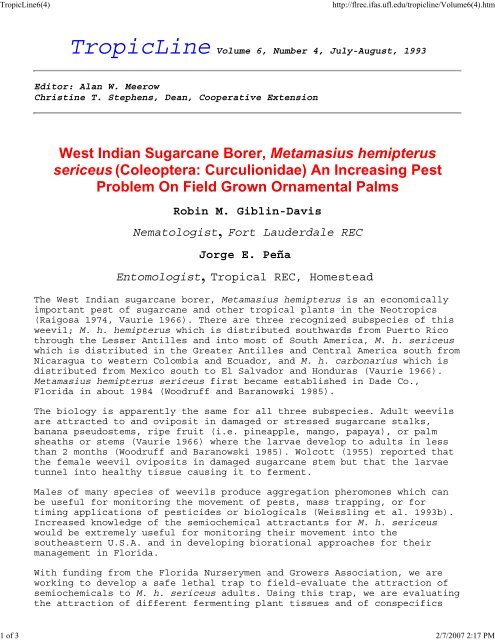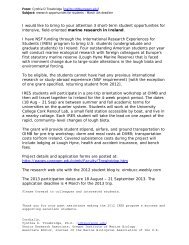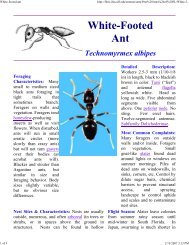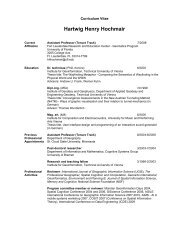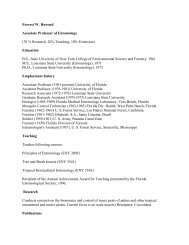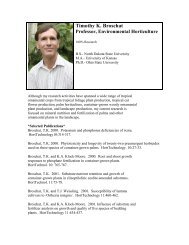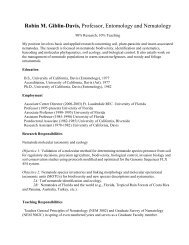West Indian Sugarcane Borer, Metamasius hemipterus sericeus ...
West Indian Sugarcane Borer, Metamasius hemipterus sericeus ...
West Indian Sugarcane Borer, Metamasius hemipterus sericeus ...
You also want an ePaper? Increase the reach of your titles
YUMPU automatically turns print PDFs into web optimized ePapers that Google loves.
TropicLine6(4) http://flrec.ifas.ufl.edu/tropicline/Volume6(4).htm<br />
TropicLine Volume 6, Number 4, July-August, 1993<br />
Editor: Alan W. Meerow<br />
Christine T. Stephens, Dean, Cooperative Extension<br />
<strong>West</strong> <strong>Indian</strong> <strong>Sugarcane</strong> <strong>Borer</strong>, <strong>Metamasius</strong> <strong>hemipterus</strong><br />
<strong>sericeus</strong> (Coleoptera: Curculionidae) An Increasing Pest<br />
Problem On Field Grown Ornamental Palms<br />
Robin M. Giblin-Davis<br />
Nematologist, Fort Lauderdale REC<br />
Jorge E. Peña<br />
Entomologist, Tropical REC, Homestead<br />
The <strong>West</strong> <strong>Indian</strong> sugarcane borer, <strong>Metamasius</strong> <strong>hemipterus</strong> is an economically<br />
important pest of sugarcane and other tropical plants in the Neotropics<br />
(Raigosa 1974, Vaurie 1966). There are three recognized subspecies of this<br />
weevil; M. h. <strong>hemipterus</strong> which is distributed southwards from Puerto Rico<br />
through the Lesser Antilles and into most of South America, M. h. <strong>sericeus</strong><br />
which is distributed in the Greater Antilles and Central America south from<br />
Nicaragua to western Colombia and Ecuador, and M. h. carbonarius which is<br />
distributed from Mexico south to El Salvador and Honduras (Vaurie 1966).<br />
<strong>Metamasius</strong> <strong>hemipterus</strong> <strong>sericeus</strong> first became established in Dade Co.,<br />
Florida in about 1984 (Woodruff and Baranowski 1985).<br />
The biology is apparently the same for all three subspecies. Adult weevils<br />
are attracted to and oviposit in damaged or stressed sugarcane stalks,<br />
banana pseudostems, ripe fruit (i.e. pineapple, mango, papaya), or palm<br />
sheaths or stems (Vaurie 1966) where the larvae develop to adults in less<br />
than 2 months (Woodruff and Baranowski 1985). Wolcott (1955) reported that<br />
the female weevil oviposits in damaged sugarcane stem but that the larvae<br />
tunnel into healthy tissue causing it to ferment.<br />
Males of many species of weevils produce aggregation pheromones which can<br />
be useful for monitoring the movement of pests, mass trapping, or for<br />
timing applications of pesticides or biologicals (Weissling et al. 1993b).<br />
Increased knowledge of the semiochemical attractants for M. h. <strong>sericeus</strong><br />
would be extremely useful for monitoring their movement into the<br />
southeastern U.S.A. and in developing biorational approaches for their<br />
management in Florida.<br />
With funding from the Florida Nurserymen and Growers Association, we are<br />
working to develop a safe lethal trap to field-evaluate the attraction of<br />
semiochemicals to M. h. <strong>sericeus</strong> adults. Using this trap, we are evaluating<br />
the attraction of different fermenting plant tissues and of conspecifics<br />
1 of 3 2/7/2007 2:17 PM
TropicLine6(4) http://flrec.ifas.ufl.edu/tropicline/Volume6(4).htm<br />
with and without fermenting plant tissue to M. h. <strong>sericeus</strong> adults in the<br />
field.<br />
Lethal traps baited with 250 g of chopped sugarcane were used to survey<br />
plantings of sugarcane, banana, or ornamental palms in Broward (3 sites),<br />
Dade (10 sites), and Palm Beach (8 sites) Counties during March-September<br />
1993. Each survey location received 2-7 traps. We worked with Broward,<br />
Dade, and Palm Beach county extension units, personnel with the Florida<br />
Department of Agriculture and Consumer Services, Division of Plant<br />
Industry, and cooperative growers to locate active M. h. <strong>sericeus</strong><br />
infestations and candidate sites for survey and observation of symptoms in<br />
host plants.<br />
<strong>Metamasius</strong> <strong>hemipterus</strong> <strong>sericeus</strong> were trapped near and in banana plantings,<br />
sugarcane fields, and fields of ornamental palms in southern Dade County<br />
and Pahokee and Belle Glade, Palm Beach County. In central and western<br />
Broward County, M. h. <strong>sericeus</strong> were trapped near and in small banana<br />
plantings and fields of ornamental palms.<br />
We observed larval infestations of M. h. <strong>sericeus</strong> in the following palms<br />
during 1991-1993 in Florida: 1) forty healthy (Dade Co.) and about 20<br />
wounded (Dade and Broward Co.) 3-4-year-old, field grown spindle palms,<br />
Hyophorbe verschaffeltii; 2) two 3-4-year-old healthy Canary Island date<br />
palms, Phoenix canariensis in Dade Co.; 3) three healthy MacArthur palms,<br />
Ptychosperma macarthurii in Dade Co.; 4) more than one hundred 3-4-year-old<br />
healthy field grown Majesty palms, Ravenea rivularis in Palm Beach Co.; 5)<br />
six 3-4-year-old healthy field grown royal palms, Roystonea regia in<br />
Broward and Palm Beach Co.; and 6) two 3-4-year-old healthy Washington fan<br />
palms, Washingtonia robusta in Dade Co.<br />
<strong>Metamasius</strong> <strong>hemipterus</strong> <strong>sericeus</strong> larval tunneling appeared to start in<br />
petioles or wounds in the petioles, crown, or stem and was extended into<br />
healthy stem tissue. Symptoms that we observed included: 1) the appearance<br />
of a dark amber-colored gummy exudate which issued from openings to the<br />
surface from larval galleries in the stem and petioles of the crown region<br />
or sometimes in the stem near or amongst exposed roots (R. regia); and 2)<br />
open 1.0-1.5 cm diam. larval galleries in the leaves, petioles, and stem.<br />
Signs included abandoned cocoons made of stem or petiole fibers, and/or<br />
adult, larval, and pupal weevils at the base of petioles and in galleries<br />
in the stem. The overall symptoms were of a lethal wilt with general<br />
chlorosis and premature leaf death in all of the P. macarthurii, and in<br />
several H. verschaffeltii and R. rivularis examined. Eventually, the crown<br />
in these palms was completely destroyed by larval tunneling and collapsed.<br />
Because the smooth, columnar trunks of H. verschaffeltii, R. rivularis, and<br />
R. regia are an important part of their aesthetic appeal, even light damage<br />
by M. h. <strong>sericeus</strong> is of economic importance. The W. robusta that we<br />
examined were booted (with old petioles attached) and assymptomatic for M.<br />
h. <strong>sericeus</strong> damage until the boots were removed near the crown revealing<br />
typical larval weevil damage. Booted species of palms would have a higher<br />
threshold for aesthetic damage to trunks but could suffer because high<br />
densities of undetectable M. h. <strong>sericeus</strong> might build-up and stress or kill<br />
the tree or provide access for pathogenic organisms. Palms that are<br />
assymptomatic for early M. h. <strong>sericeus</strong> damage could escape early detection<br />
and provide refuge during insecticide treatments in palm field nurseries. A<br />
chemically-mediated lethal trap for M. h. <strong>sericeus</strong> would be extremely<br />
useful for monitoring, mass-trapping, or pathogen delivery in such cases.<br />
2 of 3 2/7/2007 2:17 PM
TropicLine6(4) http://flrec.ifas.ufl.edu/tropicline/Volume6(4).htm<br />
UPDATES TO THIS ARTICLE: Update 1, Update 2<br />
REFERENCES CITED<br />
Raigosa, J. 1974. Nuevos disenos de trampas para control de plagas en caña<br />
de azucar (Saccharum officinarum L.). Memorias II Congreso de la Sociedad<br />
de Entomologia Colombiana, Julio 7 al 10 de 1974, Cali, Colombia. pp. 5-23.<br />
Vaurie, P. 1966. A revision of the Neotropical genus <strong>Metamasius</strong><br />
(Coleoptera, Curculionidae, Rhynchophorinae). Species groups I and II.<br />
Bull. American Mus. Nat. Hist. 131:213-337.<br />
Weissling, T. J., R. M. Giblin-Davis, G. Gries, R. Gries, A. L. Perez, H.<br />
D. Pierce, Jr., and A. C. Oehlschlager. 1993b. An aggregation pheromone of<br />
the palmetto weevil, Rhynchophorus cruentatus (F.) (Coleoptera:<br />
Curculionidae). J. Chem. Ecol. 19: (in press).<br />
Wolcott, G. N. 1955. Entomologia economica Puertorriquena. Univ. Puerto<br />
Rico Estac. Exp. Agr. Bull. 125: 1-208.<br />
Woodruff, R. E., and R. M. Baranowski. 1985. <strong>Metamasius</strong> <strong>hemipterus</strong><br />
(Linnaeus) recently established in Florida (Coleoptera: Curculionidae).<br />
Florida Dept. Agric. & Consumer Serv. Division of Plant Industry,<br />
Entomology Circular No. 272. 4 pp.<br />
3 of 3 2/7/2007 2:17 PM


